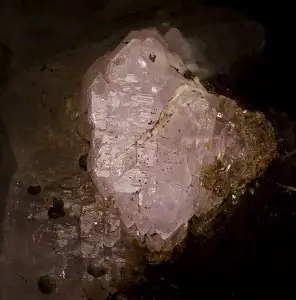
FACT 1: The formula of quartz is silicon dioxide. Quartz has the hardness of seven magnitudes and has a vitreous lustre.
FACT 2: Quartz seems to be a polymorph of stones called Tridymite, Cristobalite, Seifertite, Coesite, Moganite, and Stishovite. Quartz is observed to have a structure  similar to that of Berlinite.
FACT 3: Quartz exists in various colors like; purple, red, black, yellow, brown, blue, colorless, green, rose, orange, etc. The various forms of quartz are displayed in the Smithsonian Museum of Natural History.
FACT 4: The measured density of quartz is 2.65 to 2.66 grams per cm3.
FACT 5: Quartz is characterized by its brittle tendency and its rhombohedral cleavage pattern.
FACT 6: Quartz is classified as 3-2 trapezohedral type belonging to the (H-M) class according to the crystallography data.
FACT 7: The crystallography data reveals the cell parameters ‘œA’ with the value of 4.9133 angstroms and ‘œC’ with the value of 5.4053 angstroms. The unit cell volume was calculated as V113.00 angstroms.
FACT 8: The Crystallography described its crystal system as trigonal. At 573 degrees centigrade, the trigonal low quartz will be transformed into a hexagonal high quartz reversibly.
FACT 9: The structure of quartz comprises a tetrahedral SiO4 where the silicon atom is bound to four oxygen atoms. Every oxygen atom is found to be attached to two silicon atoms. The structure resulting from the above arrangement will be a three-dimensional framework. This arrangement classifies the quartz into tectosilicate or framework silicate.
FACT 10: Â Quartz is found excessively in igneous, hydrothermal, metamorphic, and sedimentary environments.
FACT 11: Silicic rock types of plutonic igneous rocks are found to be rich in quartz. The composition of quartz in these rocks varies from quartz diorite to granite.
FACT 12: Quartz is commonly observed to be present in quartz latites and rhyolites of volcanic rock types.
FACT 13: Quartz is commonly seen to be present in welded silicic tuffs and not seen in vitric silicic tuffs.








April 21, 2013 6:44 pm
They are really interesting facts
December 4, 2013 1:37 pm
You are an amazing and inspiring dude. I want to be you!!!<3